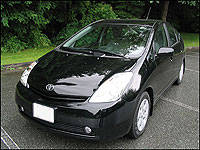Seeing the first generation Prius and the new one on the road together is an eye opener, being that the physical difference
 |
| The physical difference between the first and second generation of the Prius is like night and day; the 2004 model year has evolved in every respect. (Photo: Alexandra Straub, Canadian Auto Press) |
between the two is like night and day. The 2004 model year Prius has evolved in every respect. It now has a wheelbase nearly 150 mm longer than the previous car, which gives it greater interior room and a smoother ride. The exterior styling has also changed from a 4-door sedan configuration to a 5-door hatchback, making it one of the most aerodynamic production vehicles in the world. The super-low 0.26 coefficient of drag (Cd) helps minimize interior noise and enhance fuel economy as well. While I'm not a scientist (I gave that up for a journalism career), and I am hardly fluent in scientific terminology, it's not difficult to appreciate just how quiet the car is. Toyota didn't stop at just lengthening the wheelbase for upgraded comfort and ride quality. No, the Japanese automaker built the new model with a "monoform" design providing increased passenger and cargo space to move what was a compact car up to the mid-size class: 96.2 cubic feet in comparison to 89.0 cubic feet and 101.7 cubic feet in the Toyota Camry. Trunk space also increased to 16.1 cubic
 |
| The new Prius is the first car to utilize Hybrid Synergy Drive (HSD); Toyota's third-generation gas/electric hybrid powertrain technology. (Photo: Alexandra Straub, Canadian Auto Press) |
feet, nearly as much as the Camry trunk and over 3 cubic feet more that its predecessor. Despite the Prius' augmented dimensions, it's the upgraded engine that drives home with the prize. The new Prius is the first car to utilize Hybrid Synergy Drive (HSD); Toyota's third-generation gas/electric hybrid powertrain technology. The advanced system produces more power from both the gasoline engine and electric motor, giving the 2004 Prius acceleration (0-100 km/h in about 10 seconds) comparable to a mid-size car and quite a bit quicker than the previous model (0-100 km/h in 12.7 seconds). Furthermore, the 1.5-liter, electronically fuel injected, 16-valve, DOHC,
Atkinson Cycle gasoline engine is more powerful, upping output to 76 hp from 70. Torque is up only by 3 lb-ft, from 82 to 85. Like all other Toyota passenger cars, the internal combustion engine is equipped with variable valve timing with intelligence (VVT-i), optimizing power delivery across the rev range.







